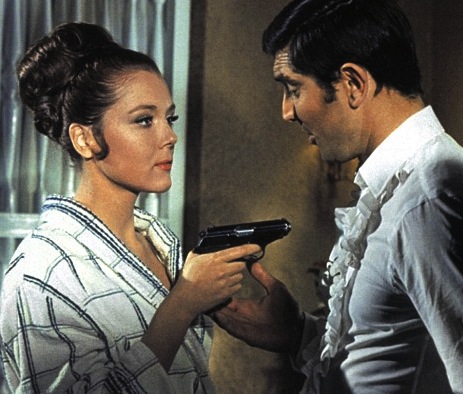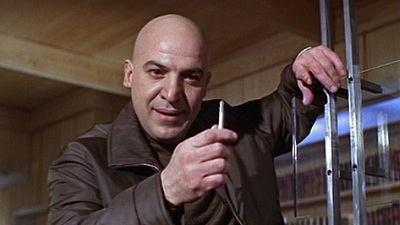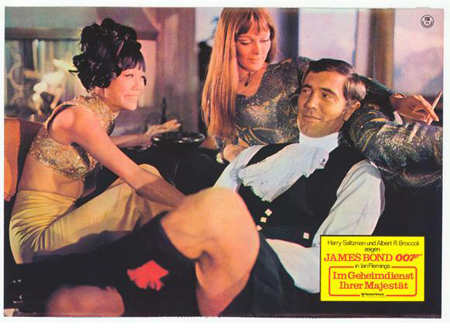 ON HER MAJESTY’S SECRET SERVICE (1969); Dir. Peter Hunt; Starring George Lazenby, Diana Rigg and Telly Savalas; Plaza Theatre; Saturday, July 6 @ 7:30 p.m.; Tickets here; Trailer here.
ON HER MAJESTY’S SECRET SERVICE (1969); Dir. Peter Hunt; Starring George Lazenby, Diana Rigg and Telly Savalas; Plaza Theatre; Saturday, July 6 @ 7:30 p.m.; Tickets here; Trailer here.
By Aleck Bennett
Contributing Writer
Throughout the month of July, the historic Plaza Theatre is paying tribute to 50 years of James Bond. And while much will be made of the many great entries starring Sean Connery, Roger Moore, Pierce Brosnan and Daniel Craig, I’d like to focus some attention on one film you may have written off: 1969’s ON HER MAJESTY’S SECRET SERVICE (OHMSS).
The tumult of the 1960s came to a head in that decade’s final year. The optimism of the Kennedy era and multi-national political intrigue had given birth to the cinematic Bond. But as the decade progressed and global politics came to be viewed in increasingly complex shades of grey, the Bond series changed as well. The films began departing freely from Ian Fleming’s novels and relying more and more on spectacular gadgetry and hyper-stylized set design, which reflected the culture’s growing fascination with pop art. The pairing of pop art and the burgeoning psychedelic art movement came to a head with 1967’s colorful and nearly cartoonish YOU ONLY LIVE TWICE (1967, YOLT for short) [Ed. note: plays Friday July 5 at The Plaza]. And if the onset of the late ‘60s were when change really began to ramp up, this too was reflected in Bond: series stalwart Sean Connery announced during YOLT’s filming that he was retiring from the role.
Aesthetically speaking, 1968-69 was a time of pulling back. Music from The Beatles, Bob Dylan, Creedence Clearwater Revival and The Band reflected a retreat from the rococo excesses of psychedelia. Meanwhile, movies like BONNIE AND CLYDE (1967) and THE WILD BUNCH (1969) inspired a newfound emphasis on realism in film. Politically speaking, the rise of the feminist movement and its influence offered a vocal critique of the seemingly disposable nature of the neverending series of “Bond girls” presented in the series thus far. Bond—with his fantastic toys and rampant womanizing—was rapidly becoming dangerously old-fashioned.
It was time to do something different.
“This never happened to the other fellow.” — James Bond, ON HER MAJESTY’S SECRET SERVICE

Tracy (Diana Rigg) is every bit the equal of James Bond (George Lazenby) in ON HER MAJESTY'S SECRET SERVICE (1969).
After attempting to woo eventual Bond lead Roger Moore for an adaptation of THE MAN WITH THE GOLDEN GUN, development on that title stalled and Moore returned to the TV series THE SAINT. Series producers Harry Saltzman and Albert “Cubby” Broccoli, along with director Peter Hunt, then decided to revive earlier plans to adapt OHMSS. And for their new Bond, turned to a relative unknown: Australian commercial actor George Lazenby.
The pairing of Lazenby and Bond started off on a bad note. Lazenby had been offered a seven-picture deal by Broccoli, but his agent advised against signing. The times were changing, the agent reasoned, and predicted that Bond couldn’t continue into the ‘70s. To add to the problem, by all accounts Lazenby and co-star Diana Rigg didn’t get along, and the actor complained of a lack of communication and coaching (this being his first feature film) from director Hunt.
Despite the unsure footing of the new star, every effort was made to try to make this the definitive Bond picture. The creative team decided to make this film hew as closely as possible to Fleming’s original novel, to the point of having Telly Savalas’ Blofeld (who had already been introduced in YOLT) not recognize Bond upon meeting him—a result of the novel having predated the previously-adapted YOLT. The movie also stripped back Bond’s reliance on gadgetry and returned to a more realistic depiction (for Bond, anyway) of spy work. Most significantly, though, OHMSS reflected the changing sexual politics of the time and presented Bond with a “Bond girl” that was his equal; in return, Bond eschewed his promiscuity and devoted himself to her.
In an epic tale that reached from the beaches of Portugal to the Swiss Alps, Bond must join forces with Marc-Ange Draco (Gabriele Ferzetti), the head of a European crime syndicate, in order to track down Ernst Stavro Blofeld, head of the international terrorist organization SPECTRE. In doing so, he went undercover to reveal a sinister plot at Blofeld’s clinical allergy-research institute, put his position as a 007 agent with MI6 at risk, and found that he was falling deeply in love with Draco’s daughter, the Contessa Teresa “Tracy” di Vicenzo.

Telly Sevalas’ malevolence as villain Ernst "Stavro" Blofeld shines through even his most subdued scenes.
In my eyes, the filmmakers succeeded at their task. This truly is the definitive Bond film. It presents a James Bond who is both confident and vulnerable. Unlike any Bond outing before, the character is allowed to show fear and express true love while simultaneously providing a no-nonsense and strong presence. If anything, his depicted vulnerabilities strengthen his resolution and character. Though these elements are present in Fleming’s novel, to allow them in the film was a brave turn by the Bond team.
Despite Lazenby’s lack of experience and occasional lack of finesse, his performance was solid. A formidable presence, he retained some of Connery’s suavity while still offering a more serious and sinewy take on the character. Savalas’ Blofeld was allowed to be a truly physical threat, unlike Donald Pleasence’s “evil genius” take on the role, and Savalas’ malevolence shone through even his most subdued scenes. Finally THE AVENGERS star Diana Rigg was perfect as Tracy. Displaying a complexity that matched this complex movie, she delivered a Tracy in turns melancholy, witty, intelligent and joyous. She captured the emotional arc of the character pitch-perfectly.
And for all the film’s distance from by-that-point traditional Bondian high-tech wizardry, OHMSS didn’t skimp on action in the slightest. For its length (it’s the second-longest Bond title), it plays lean and muscular. While the film wasn’t received well upon its release and still divides critics more so than probably any other Bond film, it delivers everything a Bond movie should.
That Lazenby did little to help his relationship with Saltzman and Broccoli (his appearing at the film’s premiere with shoulder-length hair and a beard was probably the last straw) probably served to hurt the film’s reputation more than anything else. Bad blood on both sides led to this film always being served up as something of the black sheep of the Bond family. It’s long been viewed as only slightly more legitimate than the 1967 parody CASINO ROYALE or the unofficial 1983 THUNDERBALL re-hash NEVER SAY NEVER AGAIN. But latter-day viewers and critics have finally started to come around and give the film its due. And it’s about time.

Are these Bond girls asking what's under George Lazenby's kilt?! Yes, while Sean Connery was a Scot, Lazenby, the stiffest Bond, was the only 007 to put that new meaning to not shaken but stirred.
Some will argue for 1965’s GOLDFINGER. Some may argue for 2006’s CASINO ROYALE. Some even will argue for Timothy Dalton’s short run as 007. But I root for the underdog. Both Lazenby and ON HER MAJESTY’S SECRET SERVICE are that underdog. GOLDFINGER is a close second, tied with last year’s SKYFALL (2012; laugh if you must, but SKYFALL is going to hold up far better than any of the Moore outings, mark my words). However, there’s nothing like MAJESTY.
Aleck Bennett is a writer, blogger, pug warden, pop culture enthusiast, raconteur and bon vivant from the greater Atlanta area. Visit his blog atdoctorsardonicus.wordpress.com









